 English
English Español
Español  Português
Português  русский
русский  Français
Français  日本語
日本語  Deutsch
Deutsch  tiếng Việt
tiếng Việt  Italiano
Italiano  Nederlands
Nederlands  ภาษาไทย
ภาษาไทย  Polski
Polski  한국어
한국어  Svenska
Svenska  magyar
magyar  Malay
Malay  বাংলা ভাষার
বাংলা ভাষার  Dansk
Dansk  Suomi
Suomi  हिन्दी
हिन्दी  Pilipino
Pilipino  Türkçe
Türkçe  Gaeilge
Gaeilge  العربية
العربية  Indonesia
Indonesia  Norsk
Norsk  تمل
تمل  český
český  ελληνικά
ελληνικά  український
український  Javanese
Javanese  فارسی
فارسی  தமிழ்
தமிழ்  తెలుగు
తెలుగు  नेपाली
नेपाली  Burmese
Burmese  български
български  ລາວ
ລາວ  Latine
Latine  Қазақша
Қазақша  Euskal
Euskal  Azərbaycan
Azərbaycan  Slovenský jazyk
Slovenský jazyk  Македонски
Македонски  Lietuvos
Lietuvos  Eesti Keel
Eesti Keel  Română
Română  Slovenski
Slovenski  मराठी
मराठी  Srpski језик
Srpski језик
Book Cover And Finishing!
2022-04-12
The dimensions of the book is very different from the cover size, they are not the same concept.
① Front/back cover size.
Generally speaking, the size of the front cover is exactly the same as the size of the back cover, which is equal to the size of the book block size.
The spread cover size will be front cover + spine + back cover.
② The size of the spine.
In book printing, the size of the cover will be calculated according to the pages numbers & paper type of the book.
If you want a hardcover book, the spine should be plus the thickness of the paper board.
Feel free to contact us to get the cover template of your book.

The cover type:
In recent years, specialty cover materials are available for hardcover books, such as cloth, linen, leather and other heavy paper. With our advanced finishing machines, extra cover finishing such as foil stamping, spot UV, embossing, debossing, glittering and flocking is also available, we do golden edges too!
① For paperback books, the cover popular with 250gsm-300gsm. Re the book block, most done with 100gsm, 128gsm, 157gsm, 200gsm. The first sheet of our book may broken if the cover too thick like 350gsm when the content with think paper like 80gsm. Feel free to contact us to get a good solution for your own book. Mostly of our books will done with lamination to make it durable, UV varnish available according to your needs.
② For hardcover books, the cover was mostly done with 157gsm printed laminated paper & mounted with grey paper board. Paper board available in 2mm, 2.5mm, 3mm, 4mm according to our book block thickness. Hardcover book covers also available in cloth, leather, PU leather.
Endpaper of our hardcover books popular with uncoated paper which also called woodfree paper. The reason is uncoated woodfree paper more durable than the coated art paper. Endpaper is a bridge to connect the book cover & block.
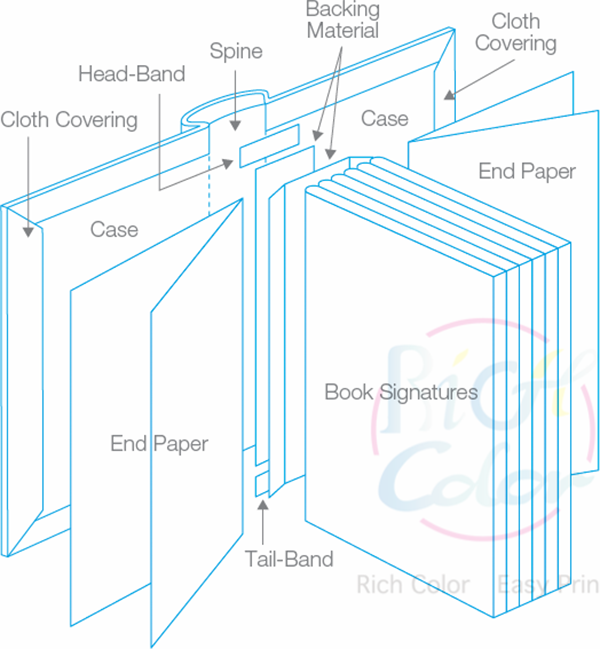
The cover finishing:
If you want to add WOW factor to your book, please feel free to contact us to add any special finishing to your art.
(1) Lamination
Popular in glossy lamination & glossy lamination, in RichColor Printing, we offer soft touch lamination & scratch-resistant lamination too. With lamination, our covers will be protected and anti-scratched. Lamination is a basic layer of all projects.
(2) Spot UV
UV Coating is a tough clear-coat applied over printed matter. It is applied in liquid form, then exposed to Ultra-Violet (UV) light which bonds and dries it instantly…hence its name "UV Coating." Spot UV is a clear gloss coating printed only on specified areas. It can be used to highlight important text and logos with a shiny sheen as well as create a subtle artistic effect when used on background objects.
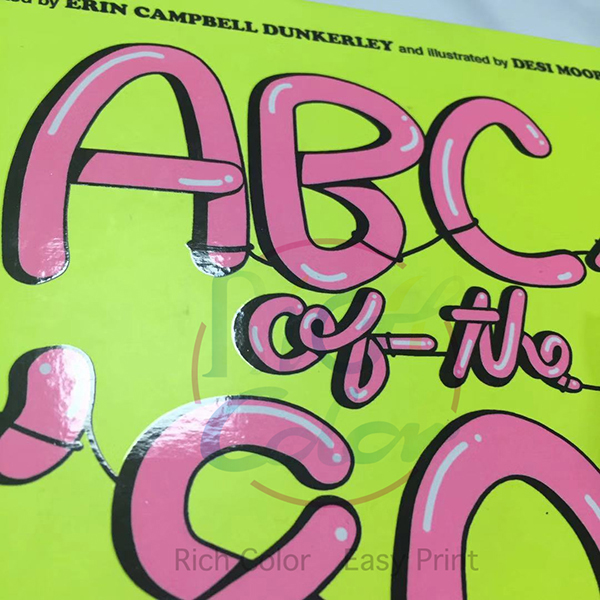
Spot UV refers to the application of this UV Coating to a specific area (or areas) of a printed piece rather than coating the entire surface. Used primarily as a design technique, Spot UV is a creative way to add depth and contrast through varying levels of sheen and texture.
Spot UV can be applied over inked images to enhance a printed design. Or, it can be applied directly to the paper substrate to create the design by itself, without the use of any ink. If applied directly to the paper, Spot UV offers the best contrast when applied over a darker substrate. In fact, a very popular finish combination is a high-gloss Spot UV over a dark, matte stock.
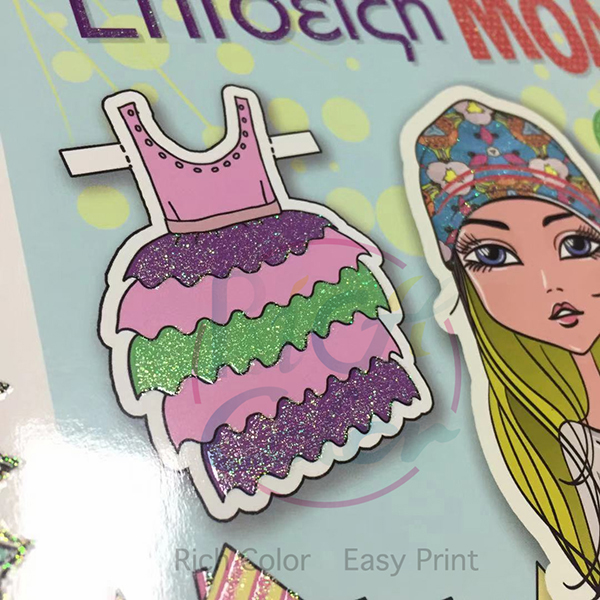
(3) Foil stamping
Foil stamping is a specialty printing process that uses heat, pressure, metal dies and foil film. The foil comes in rolls in a wide assortment of colors, finishes, and optical effects. Metallic foil is most commonly seen today – particularly gold foil, silver foil, copper foil, and holographic metallic foils – but foil rolls are also available in solid colors in both glossy and matte finishes.
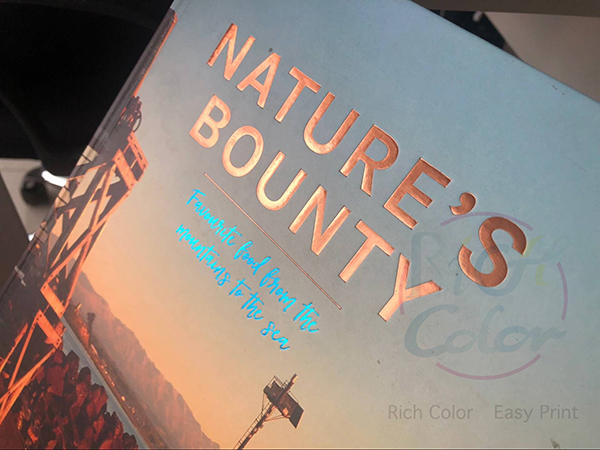
Foil stamping is somewhat similar to letterpress and engraving, in that the color is applied to paper with pressure. Once the design is finalized, metal dies are created in the appropriate shape for each individual color foil to be applied for a particular design. The dies are heated and then stamped with enough pressure to seal a thin layer of foil to the paper, and each color is applied individually through multiple runs of the press to create the final design. A final die may also be created if an embossed (raised) image or effect is desired for the design.

Texture is the feeling of a surface, real or represented. This might refer to the roughness or smoothness of actual objects and art media, or to the illusion of these properties. Texture finish is a premium print enhancement. The finish adds a relief to selected text and images that looks and feels similar to embossing.
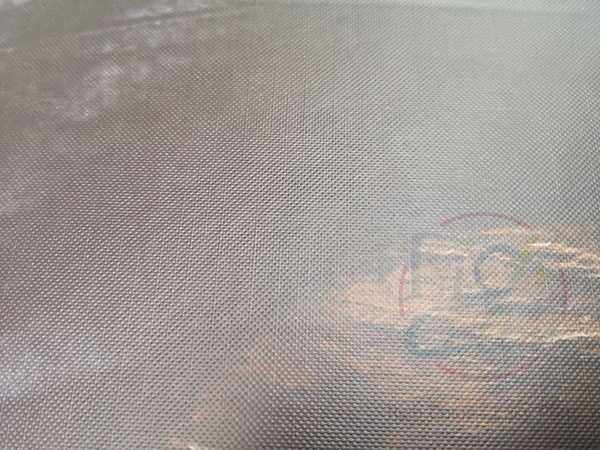
(5) Embossing and debossing
In the printing industry, Embossing refers to a method of pressing an image into paper or cardstock to create a three dimensional design. Text, logos and other images can all be formed by the embossing method. Embossing results in a raised surface, with the design higher than the surrounding paper area. A similar but less common technique is Debossing. Debossing results in a depressed surface, with the design lower than the surrounding paper area.
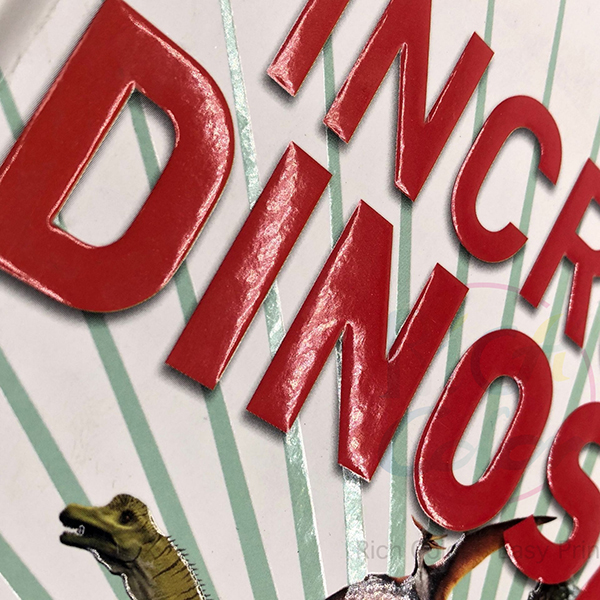
Embossing provides a look of high quality and elegance, popular in book titles, logos.
Feel free to contact RichColor Printing if any needs.
-
E-mail
-
Call Us
-
Address
4th Building, Xinxia Road 23, Pinghu, Longgang District, Shenzhen, China
Get started with a FREE consultation
At RichColor Printing, we will guide you through the entirety of the printing process from PDF making to a successful book out. Let us help bring your vision to life.




